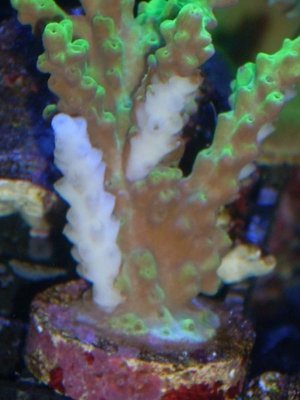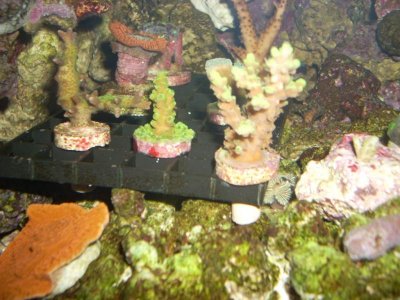ThRoewer
New member
This evening I noticed that one of my Acropora frags had in some areas "lost" it's tissue. Under the microscope it looked like it just peeled off.
I couldn't see any obvious predators and the skeleton had no algae growing on it yet.
I didn't notice anything being wrong with it last night or this morning.
It's been in my tank for about 2 months.
This is it today with one branch completely "skinned" and another missing a patch:

This was it a little over a month ago:

The green Acropora frag to the left of it is now dying slowly after being in my tank for 3 months. In those 3 months it only grew a bit on its base but never on the tip. Two weeks ago its base polyps started to expel their intestines and then started slowly to recess and die.
This one shows some microscopic organisms in the craters of the recessed polyps that look like ciliates that seem to eat the Zooxanthellae the polyps expel.
Both are not expensive or irreplaceable pieces but I better find out what is killing them before my less easy replaceable pieces get affected.
Lightsource: Kessil A360WE Tuna Blue, Imax: 100%, Cmax:
Last water test results:
Temp.: 24.7 °C (controlled by my APEX following the season table)
pH: 8.1 - 8.4 (measured by my APEX)
Salinity: 34.7 ppt (measured and controlled by my APEX controller)
Alk.: 12.1 dKh
Ca: 550 ppm
Mg: 1380
Phosphate: trace
Nitrate: 2.5 ppm
I'm dosing Bionic 2 part solution and Kalkwasser
I couldn't see any obvious predators and the skeleton had no algae growing on it yet.
I didn't notice anything being wrong with it last night or this morning.
It's been in my tank for about 2 months.
This is it today with one branch completely "skinned" and another missing a patch:
This was it a little over a month ago:
The green Acropora frag to the left of it is now dying slowly after being in my tank for 3 months. In those 3 months it only grew a bit on its base but never on the tip. Two weeks ago its base polyps started to expel their intestines and then started slowly to recess and die.
This one shows some microscopic organisms in the craters of the recessed polyps that look like ciliates that seem to eat the Zooxanthellae the polyps expel.
Both are not expensive or irreplaceable pieces but I better find out what is killing them before my less easy replaceable pieces get affected.
Lightsource: Kessil A360WE Tuna Blue, Imax: 100%, Cmax:
Last water test results:
Temp.: 24.7 °C (controlled by my APEX following the season table)
pH: 8.1 - 8.4 (measured by my APEX)
Salinity: 34.7 ppt (measured and controlled by my APEX controller)
Alk.: 12.1 dKh
Ca: 550 ppm
Mg: 1380
Phosphate: trace
Nitrate: 2.5 ppm
I'm dosing Bionic 2 part solution and Kalkwasser



